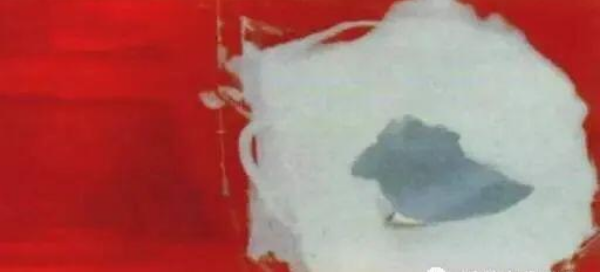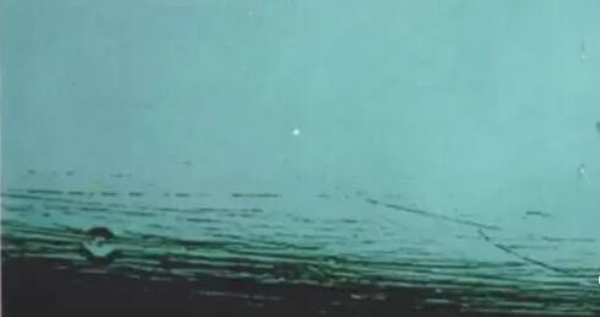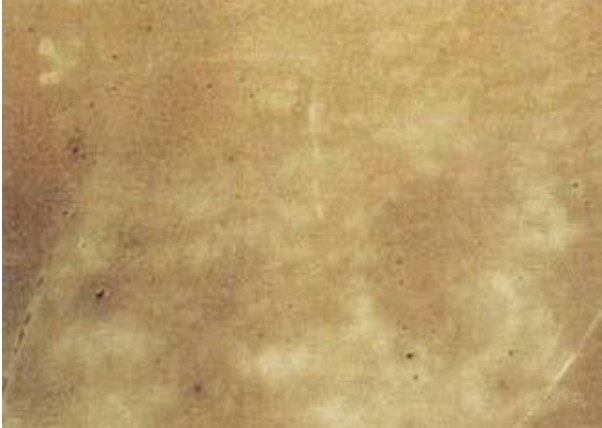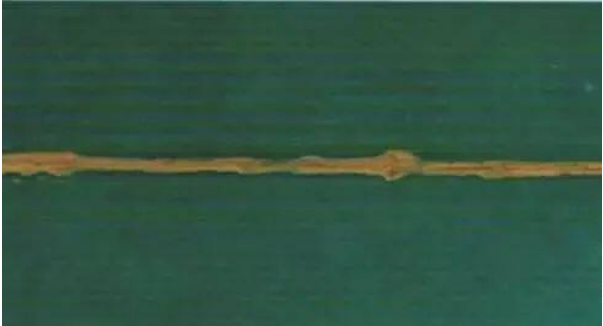

current position:Information and data>Common problems and solutions in spraying
1. The substrate peels off

Phenomenon description: The polyester filler (putty) falls off in pieces.
Reason analysis: The substrate has not been carefully prepared. Unsuitable polyester filler (putum) is used. Improper use of infrared varnishes.
Precaution:
1. The substrate must be thoroughly cleaned and polished, and the technical information must be carefully read before using polyester filling (putum).
2. Use putty and primer suitable for the substrate.
3. Follow the manufacturer's instructions when drying the infrared lacquer.
Repair method: Thoroughly sand the defective paint part, and then use the appropriate material.
2. Grinding scratches (sandpaper marks)
Phenomenon description: The edges are bulged and scratched.
Analysis of the reasons: 1. The sandpaper used to polish the metal surface or putty is too coarse, and the grooves and scratches caused by it appear through the topcoat. 2. The intermediate paint is not dry or too soft before sanding. Insufficient primer or insulation work before topcoat is applied.

Precaution:
1. Sand the specific substrate using the manufacturer's recommended type of sandpaper.
2. The base material must be thoroughly hardened before grinding.
3. Spray normal thickness of intermediate paint and top paint.
Repair method: Thoroughly sand the affected area, then re-spray.
3. Flowers

Phenomenon description: In the process of spraying or drying to form a film, the color of the paint film is locally uneven, and there are spots, streaks and chaotic hues.
Cause Analysis:
1. The solubility of the solvent is not strong, the viscosity of the construction is too low, and the stirring is not sufficient before construction. 2. If the paint film is too thick, convection occurs up and down and blooms to form small hexagonal patterns. 3. Spray equipment not cleaned. 4. When using a single-color paint to prepare a multi-color paint, the color mixing systems of different manufacturers are used, and the miscibility of the color masterbatch is poor.
Preventive measures and repair methods:
1. Select an appropriate diluent and stir the paint fully.
2. The thickness of the paint film should meet the requirements of the construction process, and the thickness of each paint film should be well controlled.
3. The spraying equipment should be thoroughly cleaned before each coating.
4. When the complex paint needs to be prepared, choose the same type of products from the same manufacturer.

Repair method: If blooming has occurred, polish the defective area and clean it thoroughly, and then spray the topcoat.
4. Poor plumpness

Phenomenon description: The gloss of the dried paint film is not good, and it appears shriveled and thick.
Reason analysis: 1. The viscosity of the coating is low. 2. The substrate or base coat is not smooth and absorbs the paint. 3. Excessive dilution.
Precaution:
1. Use the high-quality paint recommended by the manufacturer.
2. Thoroughly sand or seal the unsmooth substrate and base coat.
3. Dilute in strict accordance with process requirements.
Repair method: Polish the defective parts and re-spray.
5. Corrosion/rust
Phenomenon description: Mechanical damage and rust under the paint film.
Reason analysis: 1. Warm air and chemical agents etch metal through visible or fine cracks (sand and gravel damage) on the paint film. 2. The metal rust under the paint is not completely removed. 3. The paint covering the metal layer has been touched by a person without gloves, or the metal contaminated by chemicals accumulated during metal pretreatment, grinding water, and paint remover has been touched.
Precaution:
1. The paint parts that may be damaged by machinery must be sprayed with a protective layer that can resist sand and gravel damage during production or maintenance.
2. Thoroughly sand the exposed metal layer to remove all rust from the surface and pits. Exposed metal must be treated with metal pretreatment and rust remover.
3. Do not touch the metal parts that have been pretreated with metal by hand, and the primer process must be carried out within 30 minutes to avoid the re-formation of rust.
Repair method: remove the paint until the metal layer, and then re-spray according to the above instructions.
6. Abnormal dry spray
Phenomenon description: Although the surface of the paint film is smooth, the surface gloss of the paint film is abnormally low.
Reason analysis: 1. The primer is too poor or the primer is not dry before spraying the topcoat. 2. The diluent is too poor or inappropriate additives are added. 3. Improper pre-processing of the material or incorrect painting method. 4. The quality of the material is too poor. 5. The paint film dries too slowly at high humidity and low temperature. 6. The solvent vapor condenses on the surface of the paint film. 7. The surface is contaminated.
Precaution:
1. Select the correct type and proportion of diluent.
2. Choose the correct spray painting method: gun distance, fan shape, air pressure.
3. Use a suitable spray booth to ensure good air circulation in the spray booth.
7. Orange peel
Phenomenon description: The surface of the paint film is uneven, similar to the peel of citrus and grapefruit.
Reason analysis: 1. The construction viscosity is too large and the paint film leveling is poor. 2. Instead of choosing the matching thinner, the inferior thinner is used, and the volatilization speed is too fast. 3. Improper spraying method, too far spraying distance, too high pressure of compressed air, or improper adjustment of spray gun nozzle. 4. The leveling time after spraying is insufficient, and the temperature rises prematurely. 5. During construction in summer, the temperature of the coating environment is too high, above 35 ℃.
Precaution:
1. Use slow-drying or ultra-slow-drying diluent in high temperature environment.
2. Adjust the construction viscosity and improve the leveling of the paint film.
3. Use the correct spraying method.
4. The paint film should have a flash-off time of more than 10 minutes before baking.
5. Improve the coating environment and try to spray within the recommended temperature range.
Repair method: After the paint film is dry, smooth the orange peel and then polish it. Re-spray in severe cases.
8. Bad particles
Phenomenon description: After the coating is sprayed, irregularly sized particles or filamentous fibers appear on the surface of the coating film locally or on the entire surface.
Reason analysis: 1. The coated surface has not been thoroughly cleaned by dust removal. 2. The paint may be contaminated. 3. Dust pollution in the spraying environment. 4. Dust and fibers carried by the clothes of construction workers.
Precaution:
1. Thoroughly clean the base coat.
2. To ensure that all materials are clean, material containers should be sealed, and paint should be filtered before use.
3. Ensure that the spray booth is clean and dust-free. If necessary, the surrounding area and the ground of the spray booth can be wetted to ensure the normal operation of the air filtration system.
4. Construction workers should wear dust-proof spray paint clothes when spraying.
Repair method: After the paint film is completely cured, the slight fine particles can be smoothed with sandpaper, and then polished. If particles are deeply trapped, smooth the film and reapply.
9. Cracking
Phenomenon description: Irregular breaks or cracks occur in the paint film, usually in the gaps that are filled in the substrate or near the edge of the board. The cracks in the paint film usually show a triangular star shape, and the depth of the cracks varies, and the more serious cracks can reach the substrate.
Reason analysis: 1. The paint is not mixed evenly before spraying, the thinner is insufficient or the model is wrong. 2. Improper surface treatment, incomplete cleaning or improper filling of gaps. 3. When painting, the temperature of the substrate is too high or too low. 4. The paint film is too thick, or the leveling time between each paint is not enough, or the solvent inside the paint film cannot be volatilized in time due to the use of compressed air to dry the surface of the paint film. 5. Poor compatibility of paint.
Precaution:
1. Be sure to mix the paint evenly before spraying, and use thinner according to the specified proportion and model.
2. Carefully prepare the surface of the substrate, use the correct size of sandpaper, and fill the gap on the substrate correctly. Thoroughly clean the substrate surface, paying particular attention to the treatment around the feathered edges.
3. Correct maintenance of compressed air equipment.
4. Use the correct spraying method to ensure that the leveling time between each paint film should be sufficient
5. Make sure that the surface temperature of the substrate is within the recommended process range, and then start spraying.
Repair method: Smooth the defective area, then polish. If the surface of the paint film is too rough and cannot be repaired by the above method, the surface of the flat paint should be ground, and then repainted.
10. Hanging
Phenomenon description: In the process of spraying paint, the paint film is formed from top to bottom or the bottom edge thickens. Sagging generally occurs in vertical planes.
Reason analysis: 1. Improper construction, the distance between the spray gun and the surface to be coated is too close. 2. The speed of the gun is too slow, and the spraying is too thick at one time. 3. The viscosity of paint construction is low. 4. The construction environment temperature is low, and the paint drying time is slow. 5. When spraying by wet-on-wet process, the interval is too short. 6. The spraying pressure is lower than the process range, and the diameter of the spray gun is too large.
Precaution:
1. Use the correct spraying method to adjust the spray gun properly.
2. When diluting the paint, try to do it according to the mixing ratio, so that the construction viscosity is within the process range.
3. During construction in winter when the temperature is low, try to increase the temperature of the spray booth to ensure that it is in the range of above 10 ℃ to room temperature.
4. During the construction of the wet-on-wet process, ensure that there is enough time interval.
5. The pressure and caliber of the spray gun should meet the requirements of the process.
Repair method: When it occurs in the plain color single-process topcoat layer or varnish layer, after the paint film is completely hardened, it is polished with fine sandpaper and then polished. Re-spray in severe cases. When the base paint layer sags, smooth the sagging paint film and re-spray.
11. Topcoat dents
Phenomenon description: There are some depressions on the topcoat.
Reason analysis: 1. Incorrect spray viscosity, resting time and spray room temperature. 2. The spraying pressure is incorrect. 3. The thinner is unstable. 4. There is dirt and dust in the air.
Precaution:
1. Correctly adjust the viscosity.
2. Follow the construction method suggested in the technical data.
3. Be sure to keep the environment of the spray booth clean, and check the air filter frequently.
4. Before spraying, make sure that the body surface has been properly cleaned.
Repair method: grinding, polishing. Repaint after sanding.
12. Putty traces
Phenomenon description: The topcoat around the trimmed part bulges into a ring.
Reason analysis: 1. The substrate is not completely hardened, so that the topcoat is absorbed. 2. The sandpaper is too thick, and an inappropriate thinner is used for the topcoat. 3. The parts repaired with putty or eye filler have not been properly primed or sealed before spraying the topcoat.
Precaution:
1. Grind the repaired part until the metal layer is exposed; use thinner to perform a solvent test on the edge of the exposed paint layer. If the paint is softened, the paint layer must be sealed.
2. Putty and eye filler can only be used on exposed metal, not on the original paint surface.
3. Select the appropriate sandpaper; make sure all the preparatory materials are completely dry.
Repair method: After the repair material is dry, smooth the damaged part, isolate it with a primer material, and then re-spray.
13. Polished print (wax print)
Phenomenon description: Polished round marks of different sizes, characterized by loss of gloss, or marks left by the paint surface when polishing is insufficient.
Reason analysis: 1. Polish before the topcoat is dry; the sandpaper or polishing wax used is too coarse. 2. The paint surface is not polished enough, so that thick wax marks are left when polishing.
Precaution:
1. Check whether the topcoat is completely dry before polishing.
2. Use the polishing wax and polishing equipment recommended by the manufacturer for the specific finish.
3. Be careful when polishing paint surfaces with raised parts.
Repair method: Make sure that the topcoat has dried and then polish it. If the affected part still shows obvious wax marks, it must be polished and then sprayed again.
Hot information

